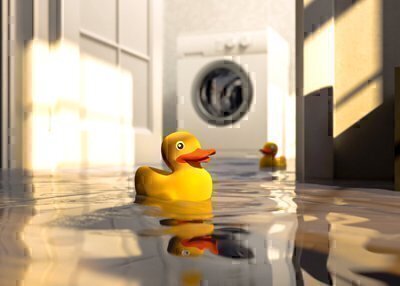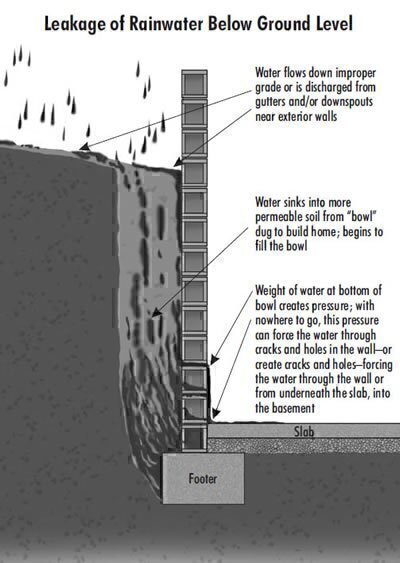How Water Gets Into Your Basement
Last updated April 2020
Wet basement? Thinking about calling a basement waterproofing contractor?
STOP.
Paying a basement waterproofing contractor to fix a wet-basement problem should be your last resort. Many of these companies will propose installation of expensive interior drainage systems—even if you don’t need them—when most moisture problems can be solved in better, less-expensive ways.
If you have water in your basement, you want it gone—pronto. But you’re more likely to get good results—and save a lot of money—by exploring all possible solutions before paying for professional help. We suggest other ways to get rid of drips (or floods) that cost far less than what most basement waterproofing contractors charge.
Want more good advice? Have an experienced home inspector or drainage specialist examine your problem and suggest solutions. Inspections cost up to $400 but could save you many times that amount. When contacting inspectors, make sure they have experience solving drainage issues.
 How It Gets In
How It Gets In
Most serious basement moisture problems occur when water leaks or seeps through basement floors, through joints between floors and walls, or through walls below ground level during or after rainstorms. In extreme cases, this water may enter in visible rivulets and accumulate several inches deep. In the mildest cases, it slowly seeps through porous wall or floor materials, creating slightly damp walls or floors.
To understand why leakage occurs, think about how a house is constructed. The first step is to dig a hole. If nothing more is done, that hole will fill with lots of water whenever it rains—falling directly into the hole, running in from the surrounding surface, or seeping in from surrounding soil. The bottom and sides of the hole may hold some water for a long time, like a giant bowl.
Now assume that built inside this bowl is a house that doesn’t quite occupy the entire bowl. How do you keep water that accumulates in the bowl out of the house? A lot can be done, but often the diligence of the builder and local building codes dictate what is actually done. Let’s assume the builder is conscientious—
- The builder backfills the hole with clean soil around the foundation to fill up the remainder of the bowl, making sure no wood, masonry, concrete, or other debris get into it, and packing the fill dirt tightly. But regardless of how carefully that work is done, backfill dirt will be less compact than the undisturbed dirt surrounding the hole. As a result, the bowl—like a full bowl of dry cereal—can still hold a lot of liquid.
- To minimize the water that gets in, a careful builder raises the backfill high enough to create a slope to carry water away from the house. Building codes usually require six inches of slope for the first 10 feet of ground; better builders grade one foot of slope for the first six feet of ground, allowing for soil settlement over time. If the grade is adequate, most rainwater will run off the surface and away from the house before it soaks too far into the fill.
- The builder tries to make the house watertight by being sure the basement floor and foundation walls have no holes or cracks, and tries to make sure that cracks will not develop as the house settles and changes with age. The tightness of the house is enhanced by parging and/or damp-proofing the foundation walls—applying coverings of cement mortar, bituminous coating, plastic vapor barrier, drainage board, or other materials to the walls.
- A drainage system is installed around the outside and/or inside perimeter of the foundation. Most building codes now require all new homes to have exterior drainage systems. Sometimes the builder may simultaneously install drainage systems on both the outside and the inside of the foundation, and connect the two systems (some jurisdictions require this step). Perforated drainage pipes are set below the level of the basement floor or alongside the footing. The pipes are surrounded by coarse gravel and may be covered with a filter fabric to keep dirt from clogging the system. The pipes collect water and drain it off to a public stormwater sewer or an open area where the slope will cause it to flow away from the house, thus keeping the bowl empty below floor level.
- Some builders limit the direct rainfall on the fill area by extending the roof of the house out beyond the walls.
- Sturdy, properly sized, and properly slanted gutters are installed, and gutter downspouts are extended to carry water well away from the house. This ensures that rain falling on the roof—in the middle of the bowl—is carried out beyond the edge of the bowl. Gutters are set high enough so that water rushing down the roof in a hard rain does not cascade beyond the outer edge of the gutters.
With this picture of top-notch building practices in mind, you can easily imagine how many things could go wrong and let rainwater leak into your basement.
Some trouble areas originate during construction. Drainage systems that are unprotected during construction can get crushed or filled with dirt. Other problems occur when builders neglect to install gutters properly, fail to damp-proof walls, or improperly locate exterior drainage.
More commonly, problems develop over time—even for carefully constructed houses. Most result from a change in grade as the backfill settles. After five or 10 years, almost every house ceases to have a “positive” grade; that is, the surrounding dirt no longer slopes away from the foundation. When this happens, water begins to run toward the foundation, accumulate, sink into the backfill, seep through existing cracks, and perhaps apply sufficient pressure to create even larger cracks. In older homes, the tar used to waterproof exterior walls disintegrates over time and leaves homes even more vulnerable.
Sometimes homeowners themselves, or landscapers they hire, inadvertently contribute to improper grading. If they prepare a new planting bed adjacent to walls by removing several inches of topsoil, and fill it with mulch but don’t provide drainage, the result is a several-inch-deep depression beside the house topped with mulch that absorbs rain rather than letting it run off. With nowhere to go, rainwater sinks into the ground beside the house.
Other less common causes of leaks: Walls settle and crack; parging or other coatings crack; gutters come loose; downspouts rust out, crack, or disconnect; exterior drain pipes get clogged with silt.

Other Possible Causes of Water Problems
In addition to problems from rainwater that permeates the soil and then seeps or leaks into the basement, there are other possible causes of water problems, each with its own cure.
Leakage of Surface Water
Generally, it’s easiest to detect and cure leakages from roof and yard runoff directly through above-grade cracks in walls, under doors, or around windows.
You may be able to redirect the water on the yard surface so that it bypasses your house—to find out whether this is possible, watch your yard during a heavy rain. If you see sheets of water running on the surface of the yard toward your house, it probably means your yard is not sloped properly and may be draining too large of an area, perhaps even adjoining properties. If this is a new problem, find out if your neighbors have recently done any major regrading or landscaping.
You can redirect surface drainage by regrading or digging a swale (discussed above) to catch and channel water away from your house. Depending on the entry path, you can also point up walls, caulk windows and doors, install window wells, build up window sills, or build low barriers at doorway footings.
Leakage of Groundwater
The most difficult-to-solve leakage problem is groundwater—that is, water that seeps in from the permanent water table beneath your house. If infiltration of water into your basement occurs several days after rainfall, or absent rainfall, you might have a groundwater leakage problem; if your basement gets wet only during or after rainfall, groundwater is not to blame. While a groundwater leakage problem will probably require an interior and/or exterior drainage system (see above), first obtain professional advice from a home inspection specialist. Note that—despite what some basement waterproofing companies might tell you—this problem is very rare.
Surcharge
Sometimes water comes up through a backed-up floor drain or from an outside storm drain. This is called surcharge, and may occur if the drain is connected to a sanitary sewer or public storm drain system. If you think surcharge may be your problem, contact sewer authorities. First, have them test the water to make sure it does not come from a sanitary sewage system. Then check nearby storm drains and catch basins for blockages. To solve surcharge problems, you may have to find an alternative way to discharge your floor drain. One possible solution, a one-way discharge valve (or “backflow preventer” or “check valve”), has fallen into disfavor in many areas because it catches debris and clogs up. Another solution is to simply close off your floor drain.
Condensation
Moisture that condenses from the air can also cause water issues. If walls, floors, or pipes are cold, and the air entering the basement is warm and high in humidity, cold surfaces can become wet. You can sometimes solve the problem by insulating water pipes and keeping windows closed during summer, except when it is cooler outside than inside. For the most severe problems, however, you will also need to install a dehumidifier, air conditioner, or both.


